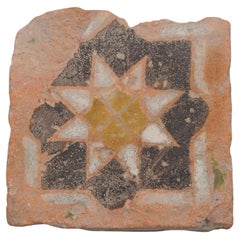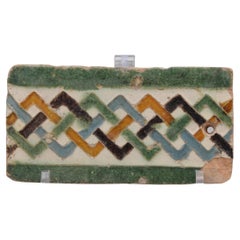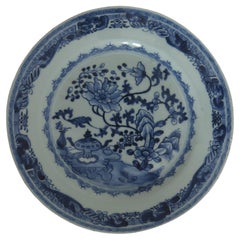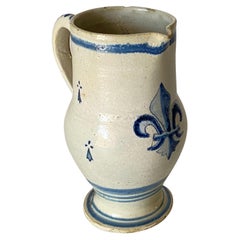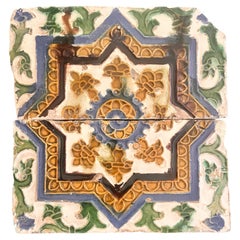18th Century and Earlier Ceramics
to
45
425
425
1,440
6,932
1,809
952
4,185
1,097
124
41
277
360
207
856
1,114
512
191
71
97
24
24
22
4
2
1
1
1
1
421
118
108
48
17
297
113
319
87
83
79
74
425
425
425
21
11
11
9
7
Period: 18th Century and Earlier
Spanish Azulejo Tile Arista y Cuenca - Toledo 16th century
Located in DELFT, NL
Early Arista y cuenca tile made in Toledo. Tile decorated in renaissance with stylized flowers was probably made between 1550 and 1575.
Category
Spanish Renaissance Antique 18th Century and Earlier Ceramics
Materials
Earthenware
Spanish Moorish Mudejar Olambrilla Tile, Cuerda Seca - Toledo 15th/16th century
Located in DELFT, NL
Rare late 15th or early 16th century Mudejar tile of the so-called ‘Arista’ or 'cuerda seca' technique.
The central motif is an eight-pointed star, which in turn encloses smaller on...
Category
Spanish Renaissance Antique 18th Century and Earlier Ceramics
Materials
Earthenware
Spanish Moorish Mudejar Tile, Arista y Cuenca - Sevilla 16th century
Located in DELFT, NL
Rare late 15th or early 16th century Mudejar tile of the so-called ‘Arista’ technique with intricate geometric decoration.
Good condition; some chipping to the edges, some wear to ...
Category
Spanish Renaissance Antique 18th Century and Earlier Ceramics
Materials
Earthenware, Clay, Maiolica
18th Century Chinese Blue and White Large Plate, Qing Qianlong circa 1750
Located in Lincoln, Lincolnshire
This is a very good Chinese porcelain large plate, made for the export (Canton) market, during the middle of the 18th century, Qing-Qianl...
Category
Chinese Qing Antique 18th Century and Earlier Ceramics
Materials
Porcelain
Jug in Pottery Beautiful Old Patina, France 18th Century, Quimper HR
Located in Auribeau sur Siagne, FR
This Jug has a great old Patina. It is from France made in the 18th Century. The material is Pottery and the condtion is Fair. the decor is "fleur de Lys".
Category
French French Provincial Antique 18th Century and Earlier Ceramics
Materials
Pottery
$334 Sale Price
20% Off
Spanish Azulejo Tiles 'Dos por Tabla' - Arista y Cuenca - Toledo 16th century
Located in DELFT, NL
Set of Spanish tiles of the 'dos por tabla/ type in the Arista y cuenca tile made in Toledo. This particular type was to adorn ceilings.
Tile decorated in renaissance with stylized ...
Category
Spanish Renaissance Antique 18th Century and Earlier Ceramics
Materials
Earthenware
Chinese Qianlong Hand Painted Porcelain Plate, 18th Century
Located in Bishop's Stortford, Hertfordshire
An exceptional antique Chinese Qianlong porcelain plate decorated in underglaze blue and overpainted in red and green glazes with light gilding with...
Category
Chinese Antique 18th Century and Earlier Ceramics
Materials
Porcelain
Cabinet Set Six Imari Dessert Plates with Dragons 18th Century Turner's Patent
By John Turner
Located in Katonah, NY
This set of six plates, crafted by John Turner around 1795, features the exquisite Imari color palette of iron red, cobalt blue, and radiant gold. The color combination creates a vib...
Category
English Chinoiserie Antique 18th Century and Earlier Ceramics
Materials
Ironstone
Chinese Imari Porcelain Plate or Bowl Qing Kangxi Mark and period, Ca 1700
Located in Lincoln, Lincolnshire
This is a beautifully hand painted Chinese Export porcelain plate or bowl from the Qing, Kangxi period, 1662-1722, fully marked to the base with the Kangxi period Artemisia Leaf mark within a double blue ring.
The plate is of dinner plate size, finely potted with a carefully cut base rim and a lovely rich glassy, white glaze with a light blue tinge.
The plate is carefully hand painted in a free flowing style, characteristic of the period, in varying shades of a clear cobalt blue, iron red and gold. The central well is decorated in the Imari style with flowering peonies, asters and other flowers and grasses, with a small insect flying above the flowers, all within two sets of concentric blue circles. The outer rim is richly decorated with flower sprigs and leaves, all within an outer blue circle.
The base of the plate has a recognized and documented hand painted Kangxi symbol of an Artemisia Leaf, within a double blue ring. See Page 168 of "How to Identify Old Chinese Porcelain" by Willoughby Hodgson and published by Forgotten Books. A Kangxi plate...
Category
Chinese Chinese Export Antique 18th Century and Earlier Ceramics
Materials
Porcelain
Chinese Stoneware Bowl or Dish Longquan Celadon Incised, Yuan Dynasty 1271-1368
Located in Lincoln, Lincolnshire
This is a very old interesting Chinese stoneware Longquan Celadon bowl or plate with incised decoration, which we date to the Yuan Dynasty, circa 1300.
The bowl is well potted on a low foot.
The bowl is an olive green colour having a celadon glaze with incised decoration to its centre of what looks like a flower stem and additionally three incised string lines to the outer wall. Unglazed parts fire to a terracotta brown colour as with the base section
The piece is unmarked but for similar pieces see the superb book: Chinese Ceramics by He Li published by Thames & Hudson, 1996; pages 164 to 184.
NOTES
Longquan is a city in South west China. These wares were produced over a long time period from 959 to 1550; which covers the Northern Song, Southern Song...
Category
Chinese Other Antique 18th Century and Earlier Ceramics
Materials
Stoneware
Chinese Kangxi period Porcelain Plate Kakiemon-Imari decoration, Qing Ca 1690
Located in Lincoln, Lincolnshire
This is a beautifully hand painted Chinese Export porcelain Plate from the Qing, Kangxi period, 1662-1722.
The plate is finely potted with a carefully cut base rim and a lovely rich...
Category
Chinese Chinese Export Antique 18th Century and Earlier Ceramics
Materials
Porcelain
Nevers Revolutionary 18th Century Polychrome Tin-Glazed Faïence Earthenware Plat
By Nevers
Located in Pearland, TX
A lovely 18th century Nevers earthenware plate featuring Revolutionary decoration of the Three Orders surmounted by a crown and the inscription "Union Force".
Category
French Country Antique 18th Century and Earlier Ceramics
Materials
Ceramic, Faience, Paint
FOUR 17th Century Delft Blue and White Wall Tiles on Frame Set 2, Netherlands
Located in Lincoln, Lincolnshire
These are Four Delft ceramic wall tiles mounted on a modern wood frame, all with a blue and white hand painted flower pattern, made in the Netherlands during the 17th century, circa ...
Category
Dutch Dutch Colonial Antique 18th Century and Earlier Ceramics
Materials
Earthenware
Chinese Porcelain Plate or Bowl Qing Kangxi Mark and Period, Ca 1700
Located in Lincoln, Lincolnshire
This is a beautifully hand painted Chinese Export porcelain Plate or Bowl from the Qing, Kangxi period, 1662-1722, fully marked to the base with the Kang...
Category
Chinese Chinese Export Antique 18th Century and Earlier Ceramics
Materials
Porcelain
Rare Meissen Marcolini Porcelain Chinoiserie Incense Burner Vase and Cover
Located in Queens, NY
A rare Meissen Marcolini Porcelain Chinoiserie incense burner vase and cover, made for the Chinese market, circa 1800, blue cross swords and star mark, Pressnummer 58
A Museum Quality Piece.
Painted in the sought after famille rose palette with sprigs of indianische Blumen and enriched in gilding, the simulated pierced body supported by four feet painted with stylized dragons, the pierced cover with a Buddhist lion finial.
10" high x 6" wide x 6" deep
The shape of this piece, which appears to be unrecorded in the literature, is inspired by similar Chinese porcelain censers from the Qing Dynasty, Kangxi Period (1654-1722). An example in the Palace Museum, Beijing, is illustrated by Li Yi-hua in Qing Porcelain of Kangxi, Yongzheng and Qianlong Periods from the Palace Museum Collection, Hong Kong, 1989, pl. 65. Another in the British Museum, London (museum no. PDF, A.812) is catalogued as a perfume-holder.
These porcelain examples are in turn inspired by ancient Chinese bronzes from both the Shang (1600-1046 BC) and the Zhou (1046-246 BCE) dynasties, an example of which was sold anonymously by Christie's New York, 22 March 2019, lot 1601. This chain of inspiration tracking backwards from the 19th century to antiquity provides a clear example of how ceramics, and indeed other mediums, are able to influence and motivate the works of later generations.
For a Meissen porcelain snuff...
Category
German Chinoiserie Antique 18th Century and Earlier Ceramics
Materials
Porcelain
NINE antique Delft Wall Tiles Blue & White scenes, Netherlands mainly 18th C
Located in Lincoln, Lincolnshire
These are NINE Delft ceramic wall tiles, all with different blue and white hand painted patterns, made in the Netherlands, from the 19th Century to the 17th Century, but mainly 18th Century.
Each tile is nominally slightly over 5 inches square..
All nine tiles are unique, being individually hand painted with different scenes and patterns featuring various scenes with buildings, trees, watersides, boats and one floral, with most having spider motif corners. They are all enamelled in cobalt blue, using different shades of blue, which varies slightly from tile to tile as expected:- please see the images.
Two of the tiles have scenes within double blue circles.
NOTES:
The central floral pattern tile is slightly thicker and dates to the 17th C
Seven Tiles are 18th Century and one is 19th Century ( blue tinged glaze)
Overall a beautiful set of individual hand painted antique Delft tiles...
Category
Dutch Dutch Colonial Antique 18th Century and Earlier Ceramics
Materials
Earthenware
Ceramic Traditional Hand Painted Plate by Catalan Artist Diaz Costa, circa 1960
Located in Barcelona, ES
Immerse yourself in the artistic legacy of Catalan artist Diaz Costa with our vintage hand-painted ceramic plate artwork, circa 1960. This exquisite piece captures the essence of mid...
Category
Spanish Antique 18th Century and Earlier Ceramics
Materials
Ceramic
18th Century Wedgwood & John Flaxman, Blue Jasperware "Dancing Hours" Plaque
Located in West Palm Beach, FL
18th Century Wedgwood & John Flaxman, Blue Jasperware "Dancing Hours" Plaque, England, circa 1790
This exquisite late 18th-century Wedgwood blue jasperware plaque from the "Dancing ...
Category
Antique 18th Century and Earlier Ceramics
Materials
Ceramic, Giltwood
$1,036 Sale Price
20% Off
18th Century Meissen Marcolini Candy Bowl For Ottoman Market
Located in Long Island City, NY
A German Meissen yellow porcelain candy bowl with a figural knob. The exterior of the bowl is delicately adorned with oval shaped medallions with images of bouquets of flowers, geome...
Category
German Antique 18th Century and Earlier Ceramics
Materials
Porcelain
18th Century Italian Majolica Vase Albarello
Located in Roma, IT
Antique Savona Ceramic Albarello, 18th Century
Beautiful polychrome painted majolica tree, cylindrical body with rounded shoulders from which rises a sma...
Category
Italian Louis XIV Antique 18th Century and Earlier Ceramics
Materials
Majolica
19th Century Italian Majolica Dish with Renaissance Figures
Located in San Francisco, CA
19th century Italian Majolica dish with Renaissance figures
Superb highly decorated Italian Majolica plate with hand a hand painted scene of Roman mythology; The abduction of Sabine...
Category
Italian Antique 18th Century and Earlier Ceramics
Materials
Ceramic
Chinese Kangxi period Plate porcelain Finely Hand Decorated, circa 1700
Located in Lincoln, Lincolnshire
This is a beautifully hand painted Chinese Export porcelain Plate from the Qing, Kangxi period, (1662-1722), circa 1700.
The plate is of large dinner plate size with a 10 inch di...
Category
Chinese Chinese Export Antique 18th Century and Earlier Ceramics
Materials
Porcelain
Chinese Imari Porcelain Plate or Bowl Qing Kangxi Mark & period, Ca 1700
Located in Lincoln, Lincolnshire
This is a beautifully hand painted Chinese Export porcelain Plate or Bowl from the Qing, Kangxi period, 1662-1722, fully marked to the base with the Kang...
Category
Chinese Chinese Export Antique 18th Century and Earlier Ceramics
Materials
Porcelain
Antique Ceramic Golf Tile
Located in Oxfordshire, GB
Dutch Delft Kolf Tile.
An early Dutch delft blue and white golf tile - hand painted with a Kolf scene depicting a Colf/ Kolf player. The blue image is on an off white background with...
Category
Dutch Sporting Art Antique 18th Century and Earlier Ceramics
Materials
Ceramic
18th Century Spanish or North African Faience Deep Bowl
Located in Chapel Hill, NC
A stunning Spanish or North African faience deep bowl. 18th century. Well cared for with various old rim repairs typical of the form. Red ware base. 15 1/4" diameter, 4" height.
We ...
Category
Antique 18th Century and Earlier Ceramics
Materials
Ceramic
$695 Sale Price
42% Off
Spanish Azulejo Tile Arista y Cuenca - Toledo 16th century
Located in DELFT, NL
Early Arista y Cuenca tile made in Toledo. Azulejo Toledano. Alhambra tile decorated in renaissance mudejar style geometrical design.
Probably made between 1550 and 1575.
In very g...
Category
Spanish Renaissance Antique 18th Century and Earlier Ceramics
Materials
Earthenware, Maiolica
Large 18-19th Century Spanish Glazed Earthenware Bowl
Located in Buisson, FR
Very rare and beautiful Spanish earthenware bowl. Wonderful decoration with a bird sitting on a vase of flowers
Sevilla, Spain, circa 1750-1850
Weathered and amazing antique repair ...
Category
Spanish Rustic Antique 18th Century and Earlier Ceramics
Materials
Earthenware
$949 Sale Price
41% Off
Large Chinese Export Punch Bowl, Painted & Gilt Decoration in Mandarin Palette
Located in Atlanta, GA
Large & Very Fine Chinese Export Punch Bowl, with Painted & Gilt decoration in the Mandarin palette. Jingdezhen region, China ca. 1780.
Category
Chinese Chinese Export Antique 18th Century and Earlier Ceramics
Materials
Porcelain
18th Century, Chinese Export Coral and Puce Porcelain Tea Service
Located in Downingtown, PA
Chinese export porcelain service spectacularly decorated with a smart coral scale ground with panels of puce flowers.
The service com...
Category
Chinese Chinese Export Antique 18th Century and Earlier Ceramics
Materials
Porcelain
Early New Hall Porcelain Coffee Can & Saucer Duo Chinese Pattern 421, circa 1800
By New Hall
Located in Lincoln, Lincolnshire
This is a hard paste porcelain coffee can & saucer duo by New Hall, hand decorated with their Chinese figure pattern number 421, dating to the English George 3rd...
Category
English Chinoiserie Antique 18th Century and Earlier Ceramics
Materials
Porcelain
Early Wedgwood Dipped Pearlware Bough Pot
By Wedgwood
Located in Fort Lauderdale, FL
A dark brown-glazed pearlware bough pot with pierced cover and applied decoration, made by Wedgwood circa 1785.
The development of a whiteware body had been a goal of ceramicists ac...
Category
British Neoclassical Antique 18th Century and Earlier Ceramics
Materials
Ceramic, Earthenware, Pearlware
Spanish Azulejo Tile Arista y Cuenca - Toledo 16th century
Located in DELFT, NL
Early Arista y cuenca tile made in Toledo. Tile decorated in renaissance with stylized flowers was probably made between 1550 and 1575.
Category
Spanish Renaissance Antique 18th Century and Earlier Ceramics
Materials
Earthenware
Early 17th Century Ottoman Empire Iznik Pottery Dish
Located in Fort Lauderdale, FL
An Iznik pottery dish made in the first half of the 17th century and decorated with chrysanthemums and tulips. The rim features the rock and wave pattern.
Under the direction of O...
Category
Turkish Islamic Antique 18th Century and Earlier Ceramics
Materials
Ceramic
Japanese Ao-Oribe Glazed Stoneware Dish, Early Edo Period, 17th Century, Japan
Located in Austin, TX
A fine and rare Japanese ao-oribe glazed minoyaki stoneware dish, late Momoyama or early Edo period, 17th century, Japan.
The circular dish of wheel thrown ...
Category
Japanese Edo Antique 18th Century and Earlier Ceramics
Materials
Stoneware
Kangxi Famille Verte Porcelain Large Dish, Qing Dynasty, 17th/18th c
Located in Austin, TX
A large and magnificent Chinese famille verte enameled porcelain large dish or charger, Qing Dynasty, Kangxi Period (1662 - 1722), circa 1700, China.
The shallow, shaped dish of fo...
Category
Chinese Qing Antique 18th Century and Earlier Ceramics
Materials
Enamel
Spanish Azulejo Tile Arista y Cuenca - Toledo 16th century
Located in DELFT, NL
Early Arista y cuenca tile made in Toledo. Tile decorated in renaissance with stylized flowers was probably made between 1550 and 1575.
Category
Spanish Renaissance Antique 18th Century and Earlier Ceramics
Materials
Earthenware
Georgian Newhall Porcelain Tea Bowl & Saucer Hand Painted, Circa 1800
By New Hall
Located in Lincoln, Lincolnshire
This is a hard paste porcelain Tea Bowl and Saucer by New Hall, dating to the turn of the 18th century, George 111rd period, circa 1800.
Both pieces are decorated over-glaze with ...
Category
English Georgian Antique 18th Century and Earlier Ceramics
Materials
Porcelain
Spanish Azulejo Tile Arista y Cuenca - Toledo 16th century
Located in DELFT, NL
Early Arista y Cuenca tile made in Toledo. Azulejo Toledano. Alhambra tile decorated in renaissance mudejar style geometrical design.
Probably made between 1550 and 1575.
In very g...
Category
Spanish Renaissance Antique 18th Century and Earlier Ceramics
Materials
Earthenware, Maiolica
DINNER SET Antique Chinese Porcelain 18C Kangxi/Yongzheng Period Blue White
Located in Amsterdam, Noord Holland
Sharing with you this fantastic and large dinner set. It consists of several dishes of various size, 3 tureens, two underplatters and two salt cellars.
All painted with a high qualit...
Category
Chinese Qing Antique 18th Century and Earlier Ceramics
Materials
Porcelain
$8,441 Sale Price
20% Off
18th Century Portuguese " Azulejos " Saint Antony"
Located in Madrid, ES
Largest collection of Portuguese tiles in the world
18th Century Portuguese "Saint Antony"
Measures: 266 cm x 280 cm
Important note: This panel is with the tiles restored 18th ce...
Category
Portuguese Baroque Antique 18th Century and Earlier Ceramics
Materials
Ceramic
Chinese Kraak period Plate or Dish Porcelain Blue and White, Ming Wanli, Ca 1610
Located in Lincoln, Lincolnshire
This is a hand-painted Chinese Export Kraak porcelain blue and white Side Plate or Dish, which we date to the Ming, Wanli period,( 1573-1620 ), datin...
Category
Chinese Chinese Export Antique 18th Century and Earlier Ceramics
Materials
Porcelain
Kangxi Period Chinese Plate Porcelain Blue & White Chenghua Mark, Circa 1680
Located in Lincoln, Lincolnshire
This is a very beautifully hand painted Chinese porcelain blue and white Dish or Plate from the Qing, Kangxi period ( 1662-1722), dating to Circa 1680 or slightly earlier
This is a well potted dish with 16 lobes or ribs, a wavy barbed rim, a very well cut foot rim and a very white glaze.
The plate is very finely hand painted in a free flowing style, characteristic of the period, in varying shades of a clear cobalt blue, from the very dark to the very light blue.
The central well is hand decorated with an iconic outdoor...
Category
Chinese Qing Antique 18th Century and Earlier Ceramics
Materials
Porcelain
18th C Chinese Large Plate Blue & White 32cm diameter, Qing Qianlong Ca 1770
Located in Lincoln, Lincolnshire
This is a good Chinese porcelain circular Platter or large plate, made for the export (Canton) market, during the middle of the 18th century, Qing-Qianlong period.
The plate is well hand decorated with much detail in varying shades of cobalt blue, with a glaze of a very soft light blue shade.
The plate has a central hand-painted pattern of bamboo and other flowers issuing from a rocky base with a fence, all within a geometric inner border. The inner rim also has a continuous decorated border design with three sections.
The reverse is undecorated..
Overall a good large diameter Chinese 18th Century blue and white Plate...
Category
Chinese Qing Antique 18th Century and Earlier Ceramics
Materials
Porcelain
18th Century Willow Dessert Service
Located in High Point, NC
Late 18th century partial dessert service in the ever popular and elegant Willow pattern. This is one of the prettiest sets we've ever had the pleasure to offer. The ceramic is so ...
Category
English Georgian Antique 18th Century and Earlier Ceramics
Materials
Ceramic
$6,500 / set
18th Century Portuguese "Azulejos" The Virgen"
Located in Madrid, ES
Largest collection of Portuguese tiles in the world
18th century Portuguese " Angels "
Measures: 364 cm x 252 cm
439 tiles
Important note: This panel is with the tiles restored 18...
Category
Portuguese Baroque Antique 18th Century and Earlier Ceramics
Materials
Ceramic
Chinese Porcelain Plate 'B' Finely Hand Decorated, Qing Kangxi, circa 1700
Located in Lincoln, Lincolnshire
This is a beautifully hand painted Chinese Export porcelain Plate from the Qing, Kangxi period, (1662-1722), circa 1700.
The plate is of large dinner plate size with a 10 inch di...
Category
Chinese Chinese Export Antique 18th Century and Earlier Ceramics
Materials
Porcelain
Chinese Kangxi mark & period Very Large Imari Dish or Plate Porcelain, Ca 1710
Located in Lincoln, Lincolnshire
This is a very beautifully hand painted Chinese Imari porcelain very large Dish or Plate / Platter from the Qing, Kangxi period, 1662-1722, dating to Circa 1710.
Very large diameter...
Category
Chinese Qing Antique 18th Century and Earlier Ceramics
Materials
Porcelain
Ancient Greek Black Glaze Ribbed Mug
Located in London, GB
Greek black-glaze ribbed mug
Athens, circa 475-425 B.C.
terracotta.
The mug is of a straight-sided, cylindrical form with seven horizontal ribs and an applied ring handle just below the lip. The base is flat with a slightly raised foot running around the circumference. The very centre of the underside is reserved and with traces of ochre pigment. Intact, some slight chipping to the glaze touched in, areas of incrustation to the base and interior.
This strikingly modern piece is a fine example of Attic black...
Category
Greek Classical Greek Antique 18th Century and Earlier Ceramics
Materials
Terracotta
Circa 1770 Delft Blue & White Plate
Located in Chapel Hill, NC
Circa 1770 Delft blue & white plate. Central handled & footed basket vase overflowing with flowers, surrounded by alternating repetive floral vases & natura...
Category
Dutch Antique 18th Century and Earlier Ceramics
Materials
Ceramic
$236 Sale Price
20% Off
Heraldic Spanish Azulejo Tile - Arista y Cuenca - Sevilla, early 16th century
Located in DELFT, NL
Important heraldic Spanish tile of the 'azulejo por tabla para techo' type, in arista y cuenca technique, made in Sevilla in the early 16th century.
Depicting a two-section tower an...
Category
Spanish Renaissance Antique 18th Century and Earlier Ceramics
Materials
Earthenware
Nevers 18th Century Polychrome Tin-Glazed Earthenware Faïence Country Home Plate
By Nevers
Located in Pearland, TX
A lovely 18th century Nevers earthenware plate featuring a charming country home, smoke billowing out of the fireplace, trees nestled around.
Category
French Country Antique 18th Century and Earlier Ceramics
Materials
Ceramic, Earthenware, Faience, Paint
Spanish Azulejo Tile Fragment Arista y Cuenca - Toledo 16th century
Located in DELFT, NL
Early Arista y cuenca tile made in Toledo. Tile decorated in renaissance style with interlacing lines ending in four stylized flowers was probably made between 1550 and 1575.
Category
Spanish Renaissance Antique 18th Century and Earlier Ceramics
Materials
Earthenware
Spanish Azulejo Tile Arista y Cuenca - Sevilla 16th century
Located in DELFT, NL
Early Arista y Cuenca tile, most likely made in Sevilla. Azulejo tile decorated with a gemetric pattern with 4 central leafs within a cirlce.
Mid 16th century
In very good conditi...
Category
Spanish Renaissance Antique 18th Century and Earlier Ceramics
Materials
Earthenware, Maiolica
18th Century Portuguese "Azulejos" Panel "River Scene"
Located in Madrid, ES
Largest collection of Portuguese tiles in the world
18th century Portuguese " Azulejos " River Scene"
Measures: 181cm x 087cm
78 tiles
Important note: This panel is with the tiles...
Category
Portuguese Baroque Antique 18th Century and Earlier Ceramics
Materials
Ceramic
Wonderful Large Tuscan Round Plate (Siena) from the 18th Century
Located in Madrid, ES
Wonderful Large Tuscan Round Plate (Siena) from the 18th Century
decorated with a battle scene.
Marked Siena with the date 1527 on the wing.
Italian majolica. .
Diameter: 45 cm.
good...
Category
Italian Rococo Antique 18th Century and Earlier Ceramics
Materials
Majolica
Mid 18th Century Glazed Ceramic Botija found in Southern Mexico
By G. None
Located in Guadalajra, Jal
This elegant antique jar was hand-crafted in Spain circa 1760; round in shape with narrow base and neck, the vessel features a rolled rim at the top accented with a mustard color gla...
Category
Mexican Spanish Colonial Antique 18th Century and Earlier Ceramics
Materials
Ceramic, Terracotta
Set Four Dutch Manganese Biblical Pottery Tiles, 18th Century
Located in Bishop's Stortford, Hertfordshire
A wonderful set of four antique Dutch ‘Delft’ style manganese tiles hand decorated with biblical scenes probably originating from Rotterdam and dating f...
Category
Dutch Arts and Crafts Antique 18th Century and Earlier Ceramics
Materials
Ceramic
17th century German Stoneware Bellarmine Jug
Located in AMSTERDAM, NH
Germany
Frechen
Circa 1620 – 1650
Bellarmine or Bartmann jug with a flower medallion.
A salt-glazed and iron-engobed bellarmine with a narrow neck, sphe...
Category
German Antique 18th Century and Earlier Ceramics
Materials
Ceramic, Faience
Spanish Azulejo Tile Arista y Cuenca - Toledo 16th century
Located in DELFT, NL
Early Arista y cuenca tiles made in Toledo. Tile decorated in renaissance with stylized flowers, probably made between 1550 and 1575.
I have four of them available, please reach o...
Category
Spanish Renaissance Antique 18th Century and Earlier Ceramics
Materials
Earthenware, Maiolica
17th Century Spanish Valencian Manises Lusterware Ceramic Plate
Located in Marbella, ES
Cerámica esmaltada con decoración de reflejo metálico
Se trata de una cerámica esmaltada, es decir, con un baño de esmalte blanco, muy puro en los mejores ejemplos, que se cuece en ...
Category
Spanish Antique 18th Century and Earlier Ceramics
Materials
Ceramic
Recently Viewed
View AllMore Ways To Browse
19th Century Spanish Large Granada Fajalauza
Aspic Mold
Axel Salto Bowl With Sung Glaze
Bear Cookie Jar
Bitossi Arabesque
Ceramic Mermaids
Ceramic Tennis Set
Ceramic Toast Rack
Chinese Sweet Meat
Chris Gustin
Corning Ware
Dansk Coffee Pot
Deldare Buffalo
Egg Pol Chambost
Eva Zeisel Museum
Faience Stein
Flintstone Cookie Jar
Fornasetti Fiat

